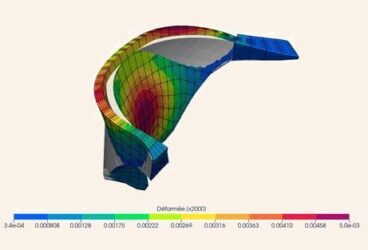As the proud owner of an electric scooter myself, I can personally attest to the engineering brilliance that has gone into the creation of electric vehicles. In my personal experience, I charge my scooter battery for 1-2 hours, and I have a 50 km range! Which, living in a large European city, just about gets me through the week. These vehicles, from cars to electric push scooters such as Lime and Tier, and electric Vespa-like scooters and motorbikes—like Emmy and Unu—are slowly but surely replacing gas-guzzling alternatives and making cities across the globe reconsider their transportation systems and pedestrian possibilities.

Yet, in order for these vehicles to enter the newly competitive electric transportation market, one thing above all is essential: Electric vehicles of all shapes and sizes need an efficient battery thermal management system in order to mature from ‘prototype’ to an actual manufactured product.
To find out more about the technical details of our new CHT solver, download and read the white paper below:
What Is Battery Thermal Management?
All main performance indicators of batteries, for any device or application, heavily depend on temperature during operation. This includes, among others, battery lifespan, capacity, and discharge rate. Under most operating conditions, keeping the battery pack within a desired temperature range requires an efficient battery cooling system that can involve air cooling, liquid cooling, thermoelectric material cooling or combinations of such. To read about more thermal cooling mechanisms, check out this article.

As these performance factors become more competitive as the electric vehicle market, in turn, becomes more saturated, a faster and more efficient method of evaluating and iterating battery cooling designs has followed suit; cloud-based simulation.
Battery Cooling for Electric Vehicles With CAE
Many of the above mentioned battery performance indicators directly influence key product features of a wide range of electric vehicles. The designs of these specific and fossil-fuel-eliminating types of vehicles have come a long way, and will continue to not only change in design, but the face of the world as we know it.
Picture a racetrack, but instead of classic race cars, electric-powered vehicles. The whole industry is competing in a race for longer ranges and faster charging times for their respective vehicles. While range limitations are obviously dominated by battery capacity and should remain high over the whole lifespan of the product, battery charge and discharge performance does not only influence charging times but also dictates acceleration performance. Hence, getting the battery thermal management system (BTMS) right is decisive for staying competitive in a fast-growing dynamic market.
The following case study explains how cloud-based simulation, using SimScale, is an invaluable tool for this task, as well as the overarching electric vehicle market.
Our Case: Bold Valuable Technology
One of our customers, Bold Valuable Technology, recently made the switch to cloud-based simulation for one of their new battery cooling designs. This particular project concerned developing a battery for a high-end electric motor sport series.
“The difficulties in accurately predicting the thermal behavior and pumping losses in the cooling system were only possible to tackle using CFD tools. The main advantage we find in simulation is the speed at which we can try different ideas and design parameters. The post-processing tools allow us to understand the behavior of the system so our engineers can come up with improvements or discover issues before building prototypes.”
Bernat Carreras, Director at Bold Valuable Technology
In order to achieve the needed results, the team wanted to evaluate their various design iterations in parallel, which is only possible through a cloud-based CFD solution. Bold ran over 100 simulations, averaging 30 core hours per runtime. They were able to gather a plethora of results, including: internal cell gradients using cutting planes, max and min cell temperatures, coolant flow streamlines, pressure drop between inlet and outlet as well as coolant temperature gradient between inlet and outlet. The outlet fluid temperature was used as a monitor for evaluating the simulation’s convergence.
Bold was able to use the plots directly from SimScale for reporting. They were also able to export the output file to analyze it further in third-party software, in order to calculate even more parameters. SimScale brought Bold a cost-effective solution by reducing the number of experimental tests needed for the project. Furthermore, it removed limitations such as the number of cores available, and enabled the possibility of having different users working remotely at any moment.
To learn more about Bold Valuable’s experience with cloud-based simulation for electric vehicle battery cooling, read their case study here.
Battery Thermal Management: Conclusion
Using cloud-based simulation, battery cooling designs for electronic vehicles—from cars to motorsport devices—can be iterated, optimized, and ultimately completed in a fast, cost-effective, and low-resource fashion.
To learn more about how to use SimScale for your battery cooling, or electronics cooling designs, check out the resources listed below:
- Battery Cooling: Challenges & Solutions
- Thermal Management: Lighting, Battery, and Enclosure Cooling Projects
- Electronics Cooling Project: LED Spotlight
- 5 Ready-To-Use Electronics Cooling Simulation Templates



